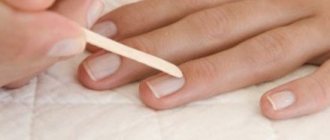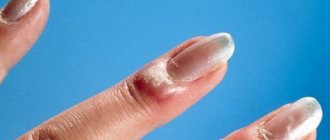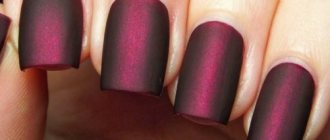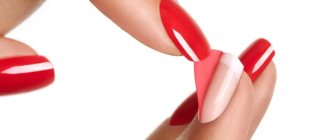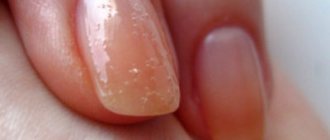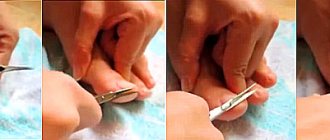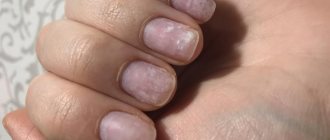The invention of the orange stick is simply ingenious. Of all the manicure items, the orange stick is perhaps the most simple item. But without it it is extremely difficult to do certain actions during manicure. About, How
use an orange stick
and what it is needed for, he will tell
website about hand and nail care Beauty-Hands.ru.
orange stick
It is a thin stick made of orange tree wood. One end of the orange stick is sharpened quite sharply, the other end is flat.
Many people probably have a question: why an orange stick and not a pine or oak stick?
The answer is very simple. Orange tree has antiseptic properties
and has a dense structure that is not prone to delamination.
In addition, manicure in its modern form was invented by the French. It was they who came up with the first manicure set and were the first to use an orange stick
.
Why and how to use an orange stick
1. Cleaning your nails.
In order to clean the inner surface of the free edge of the nail, it is convenient to use an orange stick. Take an orange stick and gently run the pointed edge under your nail. Don't forget to change the orange sticks often during this procedure.
2. Pushing back the cuticle.
With
a European manicure,
the cuticle is not cut, as with a regular manicure, but is only carefully moved away from the nail plate.
After a relaxing nail bath or after applying a special cuticle care product, you can push back the cuticles using a rubber or metal spatula. But, firstly, this is quite unhygienic. And secondly, there is a chance of damaging the cuticle. By pushing back the cuticle with the blunt end of an orange stick, you solve both problems at once. Using an orange stick will not damage the cuticle, will not cause infection and, as a result, will avoid the appearance of hangnails
and inflammation.
3. Cuticle removal.
Sometimes keratinized cuticle cells need to be removed after softening. Use the sharp end of an orange stick for this. Gently pry up the keratinized edge of the cuticle and separate it from the base layer. The main thing in this procedure is to soften the skin well. Try not to use extra effort when removing cuticles; with an orange stick you can easily remove only the excess.
4. Use for nail decoration
. An orange stick is very convenient for applying various small elements when applying glitter and rhinestones to nails. You can also use an orange stick to paint your nails with nail polish. We can say with confidence that an orange stick is a universal tool for decorative manicure.
Orange sticks come in different sizes. This applies to both the length of the stick and its thickness. The length of orange sticks varies from 9cm to 18cm.
The thickness of an orange stick usually ranges from 3-5mm. Choose the optimal length and thickness of the orange stick for yourself, then using this wonderful tool will be easy and convenient for you.
The orange stick is an individual and disposable product.
An orange tree, like any other, absorbs moisture and is difficult to treat with antiseptics, so an orange stick can become a source of infection if reused; do not reuse it.
To ensure that you can use only high-quality manicure items, purchase orange sticks, like other hygiene products, only in specialized stores or cosmetic departments.
The process of creating a manicure requires the presence of many special tools. Today the article is devoted to such an important, but at the same time absolutely unpretentious, accessory as an orange stick and how to use it. It finds application both in the hands of professional nail technicians and lovers of home nail care procedures. Why is orange wood used? Why do you need a wooden rod?
What are orange sticks for?
After reading the information below, you will understand that such sticks should always be on hand, because they are needed in almost all areas of manicure and nail design. Let's look at all these options, as well as how to use an orange stick for specific purposes.
- For cleansing nails. They can easily clean the inner surface of the nail plate. To do this, just run the pointed end under the nail. Accumulated dirt must be removed immediately or the sticks themselves must be changed more often.
- To push back the cuticle. The orange stick is the main tool for European unedged manicure. It is used here to push back the cuticle from the nail plate. This can be done with other tools (for example, a metal or rubber spatula), but this can scratch the nail or tear the cuticle (which in turn will lead to the formation of hangnails), and it is extremely unhygienic! This can be easily avoided by simply using an orange stick to push back the cuticle. After all, the material from which it is made glides pleasantly over the skin in an area of increased sensitivity.
- For removing cuticles. They easily cope with cuticle removal. Simply, after softening with a special product, carefully pry the keratinized cuticle cells with a pointed edge and separate these tissues from the main layer of the cuticle. It is important here that the cuticle is well softened, then removing excess cells with an orange stick will not be difficult.
- For removing gel polish . An orange stick is convenient to use to remove the remnants of the gel polish coating after it has been soaked with a special product. It is enough to pry the slightly loose gel polish with the flat end of the stick to then easily remove it without harm or marks on the nail plate that can be left by metal tools.
- In nail extensions . In extensions, they are used both for sticking tips and laying out forms from biogel and acrylic, and in the procedure for removing artificial nails. When the acrylic softens, it is easy to remove using this manicure tool.
- For decorating nails. To apply small objects to the nail and make a manicure with decorations - sparkles, rhinestones, appliques, then orange sticks are an indispensable thing here.
- In nail design. It can also be used for painting nails with varnish, for example, using the wet technique or instead of dots for placing dots.
- Like a lifesaver! Here I am referring to some life hacks that you can do using an orange stick. For example, you can wrap the sharp tip of a stick with a small amount of cotton wool, soak it in nail polish remover and adjust the line of polish near the cuticle if it is uneven or if the polish has flowed onto the cuticle.
Why are orange sticks needed in manicure?
Manicure in the form that it is in our modern understanding was brought into fashion by the French. They also produced the first manicure kit, which included an orange tree stick. Externally, it is a rounded rod, one end of which is flat, the other is beveled and pointed. They vary in length from 9 to 18 centimeters, in thickness from 3 to 5 millimeters.
A question that probably interests many is why exactly orange sticks are used for manicure. It is believed that the orange tree has disinfecting properties, which come in handy when treating the nail plates and cuticle area. In addition, its wood does not delaminate. The density of the stick is sufficient to gently move away dead skin, and its inherent softness does not injure the surface of the nails during the treatment process.
Despite all its simplicity, the orange stick has quite a wide range of uses:
- Pushes back and removes the cuticle during a European manicure;
- Cleanses the space under the nails;
- Used as a decorative tool.
Orange sticks for manicure
This tool bears little resemblance to a beauty innovation, which does not prevent it from being present in all basic manicure sets.
We tell you why orange sticks are indispensable ( takes 3 minutes to read)
Text: Veronika Gnezdilova Updated March 29, 2019
- Why are the sticks orange?
- How can orange sticks be useful?
- Alternative to orange sticks
They are used by both nail technicians at the best salons and those who do their own manicures at home. This is because their use does not require any special skills, and the result is well-groomed nails and hands. Let us tell you in more detail why orange sticks are needed and how to use them
How to use an orange manicure stick
How exactly to wield it in this or that case? Let's talk about this in order.
Cuticle removal
Using an orange stick in a manicure is traditionally used to get rid of cuticles. The cuticle is the skin that surrounds the base of the nail plate. The dead part is removed to create a neat appearance.
European manicure involves the abandonment of piercing and cutting instruments (nippers, tweezers) that are involved in the trimming technique. European care involves the use of a softening gel applied to the cuticle, which, in turn, is first pushed back with an orange stick.
After the proper time has passed, when the product acts on the skin, the cuticle is again removed with a wooden stick, without the risk of damaging the skin.
Cleaning your nails
Since the wooden stick has a beveled tip, it is convenient for removing dirt under the nails. The space under the free edge of the plate is very sensitive and painful. It is under no circumstances recommended to clean the area with sharp objects. Thanks to the antiseptic effect that a wooden tool has, the vulnerable area is additionally protected.
Also, when removing the decorative coating, you can use an orange stick to remove the remains of varnish or gel polish, this is clearly shown in the photo:
Nail decoration
In decoration, the orange manicure stick is a multifunctional assistant:
- Its pointed tip is useful when applying a pattern to the surface of the plate.
- A stick is convenient for gluing rhinestones, glitters, creating an applique, laying out broths, and distributing sparkles.
- For extended nails, a stick is necessary when laying out acrylic and biogel forms, tips and when removing softened acrylic.
Watch a video on how to use an orange stick to create manicure designs:
Orange manicure stick for cuticles: why is it called that?
In order to make the perfect manicure, you need a set of tools. An orange stick will be an integral assistant in this matter. Chopsticks were invented in France. But today many cannot imagine their manicure without this sorceress.
What is an orange manicure stick?
You can understand why the sticks are called that way just by seeing them, they are made from orange wood. After all, as many people know, this wood is one of the softest, but at the same time dense, which allows objects made from this wood to last a long time.
In the case of an orange stick, it has properties that prevent it from exfoliating and injuring the skin near the nails, and the nail itself. Another main advantage of orange is its antiseptic property, which plays an important role in manicure. You can read more about how to use an orange stick.
An orange manicure stick is a thin stick, one end of which is pointed, the other has a flat shape. The shape of the shelf is given with the help of a special file, which can sharpen the wood as required by the craftsman.
What is an orange manicure stick for?
There are several manicure treatments in which you can use an orange stick. For example, to clean the nail. Simply run the sharp end under your nail and all the dirt will be removed.
For the cuticle, a stick is used to make it easier to move it away. For this procedure, you can use metal sticks, but wooden ones are more hygienic and less traumatic. After all, metal can damage the nail or skin, which will lead to pain and disruption of the aesthetic appearance.
These orangewood sticks are designed for sensitive areas near the nails, allowing you to easily push the cuticle away from the nail.
The stick can also be used to remove cuticles, but before doing this you should soften it very well and apply a special product. Using the sharp side, grab the cuticle at the very edge, and its removal will take place without damage.
The stick is an essential tool in the nail extension procedure. With its help, the master can glue tips and lay out forms, or remove extended nails. After the acrylic softens, the stick will easily cope with its removal.
For nail design, a stick is used in the case of applying small objects and painting nails with varnish. With its pointed end you can easily draw the image that the girl wishes.
Types of orange sticks
It is worth saying that there are several types of orange sticks. They differ in length and width. The main thing is to choose exactly the one that will be convenient to work with.
Of course, the wand can also be used at home; here it will become a good assistant for beginners and professional craftsmen. Also, when choosing a stick, you will notice that its ends have different coatings, most often they are multi-colored. Some girls choose rubber tips instead of wood itself, but it is worth remembering that rubber is not as beneficial for the nail and is used for thin cuticle skin.
It is also worth knowing that the sticks are disposable, since during the procedure they can absorb moisture, and it is very difficult to disinfect the wood. Therefore, sets often contain several pieces, for several procedures at once. In order not to harm your nails and cuticle skin, it is better to adhere to the one-time use principle. And experts do not advise saving on such a tool, since it is very easy to be deceived. To avoid such a fate, it is better to purchase sticks in specialized stores and read about the country of origin on the label.
Orange sticks, even of the best quality, are not that expensive, so any girl can buy them.
To see how an orange stick is used in manicure art, you can watch a selection of videos or photos on the Internet. Often they can talk about all sorts of ways to use them and show them with examples.
It should be noted that orange sticks can also be used for pedicures. The principle of their use remains the same. They can clean toenails and also remove cuticles.
There are no contraindications to the use of such sticks, except for individual diseases for which a person knows for sure that such tools should not be used.
When purchasing a manicure set, the contents very rarely include sticks, and if such a tool is present, it is only in the amount of one piece. Therefore, when purchasing, it is worth purchasing a set of such sticks to make your home manicure easier.
To understand exactly what sticks you need and which ones will be more convenient to use, you can purchase several types and, after using one or another, decide which one is better and more suitable for the nails and the skin around them.
Video on the topic of the article
Peculiarities
A wooden stick is a disposable tool. After use, it is thrown away without regret. It cannot be disinfected, and repeated use risks introducing infection. In addition, wood absorbs moisture and swells. Therefore, buy a lot at once, because even during one procedure you may need several of them. The average price for a set of orange manicure sticks of 10 pieces. does not exceed 100 rubles. You can give the stick softer edges using a coarse abrasive file. Make your purchase in specialized cosmetic departments or trusted online stores to be sure of its quality.
Sticks with colored coating or rubber tips are available for sale. However, judging by the reviews, there is nothing better than the simplest one without any tricks.
How to replace an orange nail stick
An orange stick successfully competes with such manicure attributes as a pusher (scraper) and a laser file.
A pusher, or scraper as it is also called, is a double-sided metal accessory. On one side there is a kind of spatula intended for pushing back the cuticle, on the second there is a so-called hatchet for cleaning the nail bed and ridges. In addition to the hatchet, the end can be topped with a curette or spear. The tool is sharpened in such a way that you will not get hurt during a manicure, but it does its job very effectively. Improved models are equipped with a slingshot knife.
Unlike an orange stick, instruments made of medical steel can be easily disinfected and are therefore reusable. In general, they cope with all the functions of an orange wood stick with a bang. The disadvantages of pushers and scrapers are the cost and risk of injury to the nail plate. These two points make them lose to a wooden rod.
Another alternative in recent years is a laser cuticle file, which is a cross between a classic edged and European unedged manicure. Laser safe coating and compact size are the undoubted advantages of this cuticle treatment method. Manufacturers guarantee a long service life, up to a decade. In terms of cost, this beauty gadget is classified as affordable, but high-quality branded accessories will cost much more.
Now you know how to properly use an orange manicure stick. Its wide range of applications and low price make it popular among masters and girls who prefer to carry out the procedure on their own, and make it a leader among analogues. Appreciate its benefits by trying to create a manicure using an orange stick. You will not only get neat, healthy nails, but also enjoy an attractive citrus aroma!
Before the introduction of orange sticks into mass use, people could easily do without them. And they still get by. Needed or not? and if necessary, then why?
From the name it is quite clear that they should be made from orange trees, which only the Chinese actually know, but the essence is initially that the orange tree is hard enough and soft enough to process the nail plate without injuring it. In theory, it also has antiseptic properties, but... The stick itself is a disposable tool (uh-huh, disposable, if anyone didn’t know), and it should not injure anything in its essence, then, let’s be honest, you can turn a blind eye to its antiseptic properties.
But sticks are a one-piece product, and in any, even the oldest manicure set, there is a replacement for them.
I recently saw one well-worn manicure set, and its owner complained that she couldn’t do her own manicure. And no wonder! and the tools have become dull and some of them are not used at all.
found on the Internet
For example, when I was little, my mother only dreamed of wire cutters. Yes, what about wire cutters, then eyebrows were corrected with a tool with the poetic name “reisfeder.” Trimming manicures of Soviet times were performed not with scissors-cutters, but with a razor, or in manicure sets that were rare at that time, a small knife was offered. And women usually did not use spatulas, because in principle it was not customary to carry out much manipulation with the cuticles.
So even in those sets there were substitutes for orange sticks - spatulas of two shapes. One with a sharp tip, the other with a blunt one. Blunt, in theory, needs to push back the softened cuticle. And the sharp end is used to clean the nail. However, if you try to push back the cuticle with this stupid spatula, you will hear little except swearing. Well, they don’t push it back. And they never pushed it back. They smear and injure, but it does no good.
Civilization did not stand still and over time sharp spatulas appeared, one of the most common items for manicurists.
This tool is called a pusher
. They come in different shapes, but serve the same purpose - the blunt end pushes back the cuticle, the sharp end cleanses.
what is called find 5 differences
The purpose of the orange stick is exactly the same as that of the pusher. The blunt end moves away, the sharp end cleanses.
then what's the difference?
1. traumatic for the nail. The iron is quite damaging, and if your manicurist (or you yourself) uses an iron pusher, then perhaps you have noticed that without coating, shaggy patches form at the base of the nail. This is what comes from the iron pusher. Orange copes with its task much more smoothly.
2. An iron pusher is not suitable for unedged manicure. With a fairly sharp tip, it pushes back and, as it were, lifts the cuticle. If you don't trim it, it will dry out and stick out slightly. In turn, the orange moves and seems to flatten the cuticle. In general, the cuticle does not stick out, ready to be cut, but softly frames the nail in a flattened manner. Naturally, adherents of the idea that there should not be even a hint of a cuticle on the nail do not use unedged manicure at all.
Here I must say that the blunt ends of orange sticks also come in different shapes - sharper and more square, with a large beveled corner and a small one. And if you need to prepare the cuticle for trimming, then you need to choose a tip that is long enough and sharp enough to lift the cuticle. By the way, you can correct the shape of the stick with a file with a coarse abrasive.
3. hygiene. What is natural in comparing disposable and reusable instruments
____________________
By the way, you can use an orange to slightly correct the arc of the hole when coating it. And for nail art fans, paint. Pushers can't do this. but there are other special tools.
You all know that the cuticle is the skin located at the base of the nail, which primarily performs protective functions. It prevents the penetration of various bacteria into the matrix area. Therefore, the question of why remove the cuticle if it plays such an important role is very logical. The main reason is, of course, the aesthetic factor. After all, to make your nails look neat, you need to take care of your cuticles. You all know a tool that helps in this matter - orange manicure sticks have long become an indispensable attribute of a woman's cosmetics bag. But there are other devices for caring for cuticles, which we will look at in this article.
If you hear about some of them for the first time, it doesn’t matter. Explanatory photos will help you visually evaluate each of the described cuticle care devices. But first of all, it is necessary to make a small distinction between the two concepts. Cuticle removal can be done using a European or classic manicure. The latter method involves mechanical removal of the skin using cutting tools. allows you to eliminate the cuticle chemically, using special creams and oils. In addition, the skin can either simply be moved away or completely removed.
What is more correct: removing or pushing back the cuticle?
You can learn more about the topics of edged and unedged manicure on the pages of our website. Today we will try to briefly examine this issue. Throughout the world of the nail industry, unedged manicure is considered to be the most gentle and correct
. There are a number of justified reasons for this.
- Pushing back the cuticle without mechanical removal helps slow down its growth. If you use a special oil for the periungual skin, it becomes even thinner. , on the contrary, provokes active growth of the cuticle.
- Maintaining the integrity and integrity of the skin reduces the risk of infection.
- Refusal of cutting tools eliminates the possibility of accidental injuries.
- Maintaining a protective barrier at the base of the lunula reduces the level of negative environmental influences. The cuticle helps nourish and moisturize the nail plate.
Despite all the advantages of unedged manicure, it is not without its disadvantages. Therefore, every girl chooses the most convenient method for her. Let's figure out what tools you can use to care for your cuticle.
Scraper, pusher and orange sticks for manicure
You all know that the cuticle is the skin located at the base of the nail, which primarily performs protective functions. It prevents the penetration of various bacteria into the matrix area. Therefore, the question of why remove the cuticle if it plays such an important role is very logical. The main reason is, of course, the aesthetic factor. After all, to make your nails look neat, you need to take care of your cuticles. You all know a tool that helps in this matter - orange manicure sticks have long become an indispensable attribute of a woman's cosmetics bag. But there are other devices for caring for cuticles, which we will look at in this article.
If you hear about some manicure tools for the first time, it’s not a problem. Explanatory photos will help you visually evaluate each of the described cuticle care devices. But first of all, it is necessary to make a small distinction between the two concepts. Cuticle removal can be done using a European or classic manicure. The latter method involves mechanical removal of the skin using cutting tools. European manicure allows you to remove the cuticle chemically, using special creams and oils. In addition, the skin can either simply be moved away or completely removed.
What is more correct: removing or pushing back the cuticle?
You can learn more about the topics of edged and unedged manicure on the pages of our website. Today we will try to briefly examine this issue. Throughout the world of the nail industry, it is generally accepted that the unedged type of manicure is the most gentle and correct . There are a number of justified reasons for this.
- Pushing back the cuticle without mechanical removal helps slow down its growth. If you use a special oil for the periungual skin, it becomes even thinner. On the contrary, trimmed manicure provokes active growth of the cuticle.
- Maintaining the integrity and integrity of the skin reduces the risk of infection.
- Refusal of cutting tools eliminates the possibility of accidental injuries.
- Maintaining a protective barrier at the base of the lunula reduces the level of negative environmental influences. The cuticle helps nourish and moisturize the nail plate.
Despite all the advantages of unedged manicure, it is not without its disadvantages. Therefore, every girl chooses the most convenient method for her. Let's figure out what tools you can use to care for your cuticle.
Features of using an orange stick
The most commonly used manicure tool is the orange stick. It owes its name to the material from which it is made. The orange tree is famous for its excellent antiseptic properties. Its wood has a soft but very dense structure, so the manicure stick does not delaminate and does not damage the nails. It absorbs moisture quite well, so the tool is disposable, because a humid environment is an ideal place for bacteria.
Both ends of the orange stick are flat, but one of them is sharpened more and the other less. If desired, the angle of inclination can be adjusted with a regular coarse abrasive file. The orange stick comes in different lengths, ranging from 9-18 cm, and thickness, averaging 3-5 mm. There are specimens with rubber tips, but their benefits for nails are significantly lower. In the photo you can see examples of orange manicure sticks.
Looking at a simple tool, the question immediately arises about how to use it. The sharp tip of an orange stick perfectly cleanses the area under the nail from dirt. To push back the cuticle, the blunt edge of the tool is most often used. After steaming or applying a special product with an orange stick, you can completely remove dead pieces of skin. In addition, the pointed edge is very convenient for removing softened gel and acrylic coating after extensions. As a handy tool, an orange stick is used when applying rhinestones, glitter and other decorative elements to nails.
Metal cuticle spatula
In the makeup bag of many girls you can find another tool, this time a metal one. The ease of use of a manicure pusher has made it very popular among women. The ends of the metal rod come in different shapes. The edge can be made in the form of a spear, hatchet or spatula. There are models with a trimmer at the end - a knife reminiscent of a slingshot. The photo shows several varieties of pushers.
A high-quality instrument is made of medical steel. Its blade is quite sharp and does not require pre-sharpening. A pusher or scraper is easily disinfected, which is why it is popular among manicurists. The metal tool can perform all the functions of an orange stick. But it is worth noting that you should use a manicure scraper very carefully, because a steel spatula can significantly damage the nail plate. To reduce possible harm, it is better to use models with rubber tips.
Cuticle files
An average option between trimmed and untrimmed manicure is to care for the cuticle using a laser file. The special coating of the tool gently exfoliates dead cells without injuring living healthy skin and the nail itself. You will find more detailed information about various nail files in the feature article on our website, and to get a general idea of them, look at the photo.
The final video demonstrates the technology of working with a laser file, and as a bonus, considers another way to push back the cuticle - using a special pencil. Expand your horizons and discover new methods of caring for your cuticles and nails with us. Enjoy watching, dear girls!
Features of using an orange stick
The most commonly used manicure tool is the orange stick. It owes its name to the material from which it is made. The orange tree is famous for its excellent antiseptic properties. Its wood has a soft but very dense structure, so the manicure stick does not delaminate and does not damage the nails. It absorbs moisture quite well, so the tool is disposable, because a humid environment is an ideal place for bacteria.
Both ends of the orange stick are flat, but one of them is sharpened more and the other less. If desired, the angle of inclination can be adjusted with a regular coarse abrasive file. The orange stick comes in different lengths, ranging from 9-18 cm, and thickness, averaging 3-5 mm. There are specimens with rubber tips, but their benefits for nails are significantly lower. In the photo you can see examples of orange manicure sticks.
Looking at a simple tool, the question immediately arises about how to use it. The sharp tip of an orange stick perfectly cleanses the area under the nail from dirt. To push back the cuticle, the blunt edge of the tool is most often used. After steaming or applying a special product with an orange stick, you can completely remove dead pieces of skin. In addition, the pointed edge is very convenient for removing softened gel and acrylic coating after extensions. As a handy tool, an orange stick is used when applying rhinestones, glitter and other decorative elements to nails.
Orange nail sticks
Now we will look at such an integral element of the manicure world as orange sticks. They were invented in France and have become an important part of manicure tools. Without these simple sticks, it is now difficult to imagine some manicure procedures.
An orange stick is a thin stick made from the wood of the orange tree, one end of which has a pointed nose and the other is flat and beveled. You can easily shape the stick using a coarse abrasive file. Its use is the key to a neat and gentle manicure.
Why are they called that? Everything is very simple: thanks to the material from which they are made - orange wood. This tree not only gives oranges, but itself has a soft but dense structure, which does not allow the sticks to delaminate and injure the nail. Another important property of wood is that it has excellent antiseptic properties, which is important for manicure. Let's take a closer look at what orange sticks are used for in the manicure process and how to use them correctly.
The price of a package ranges from 20 to 300 Russian rubles (depending on their quantity and length). You can buy sticks in almost any store, including on Aliexpress - it’s very inexpensive!
Metal cuticle spatula
In the makeup bag of many girls you can find another tool, this time a metal one. The ease of use of a manicure pusher has made it very popular among women. The ends of the metal rod come in different shapes. The edge can be made in the form of a spear, hatchet or spatula. There are models with a trimmer at the end - a knife reminiscent of a slingshot. The photo shows several varieties of pushers.
A high-quality instrument is made of medical steel. Its blade is quite sharp and does not require pre-sharpening. A pusher or scraper is easily disinfected, which is why it is popular among manicurists. The metal tool can perform all the functions of an orange stick. But it is worth noting that you should use a manicure scraper very carefully, because a steel spatula can significantly damage the nail plate. To reduce possible harm, it is better to use models with rubber tips.



